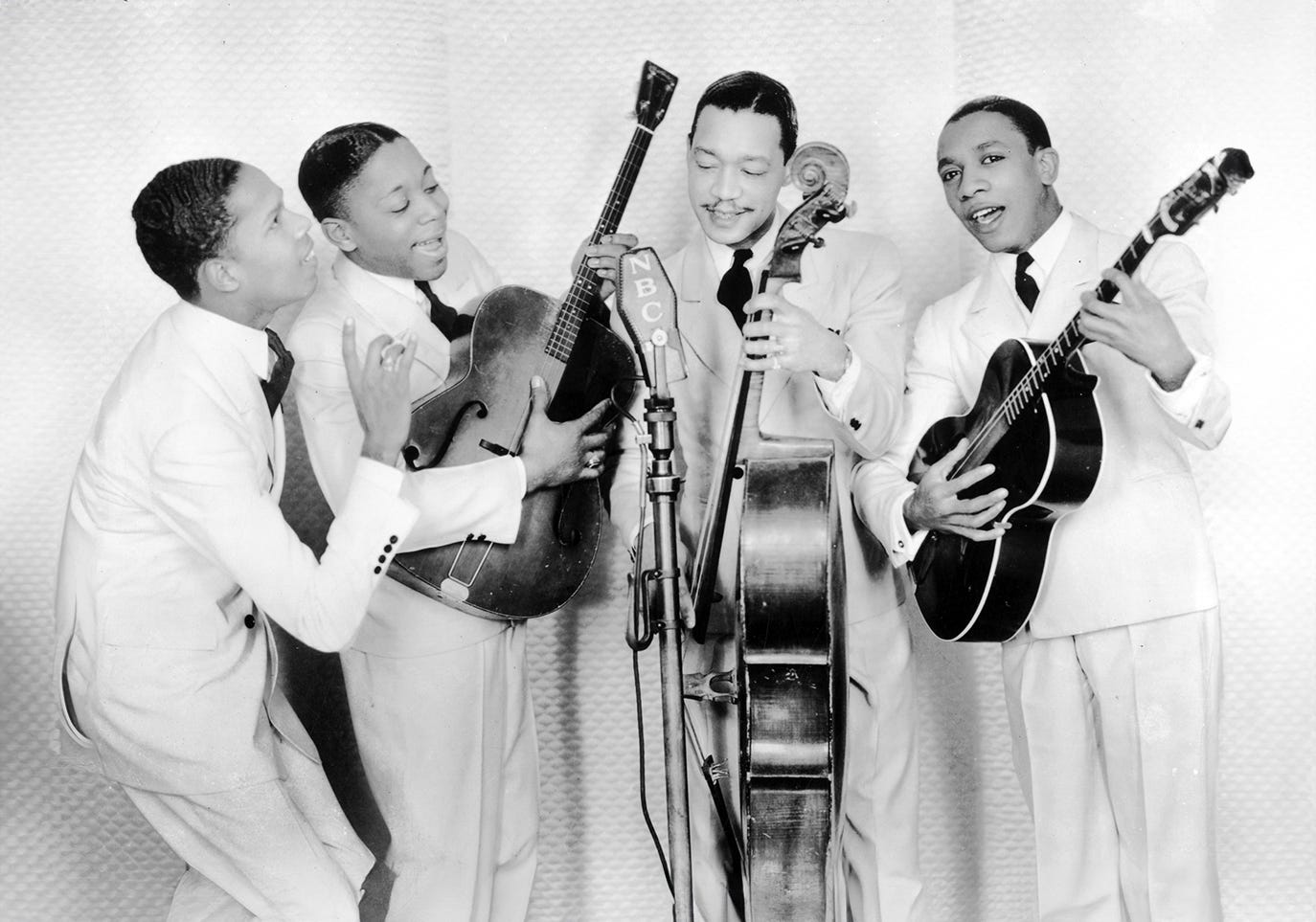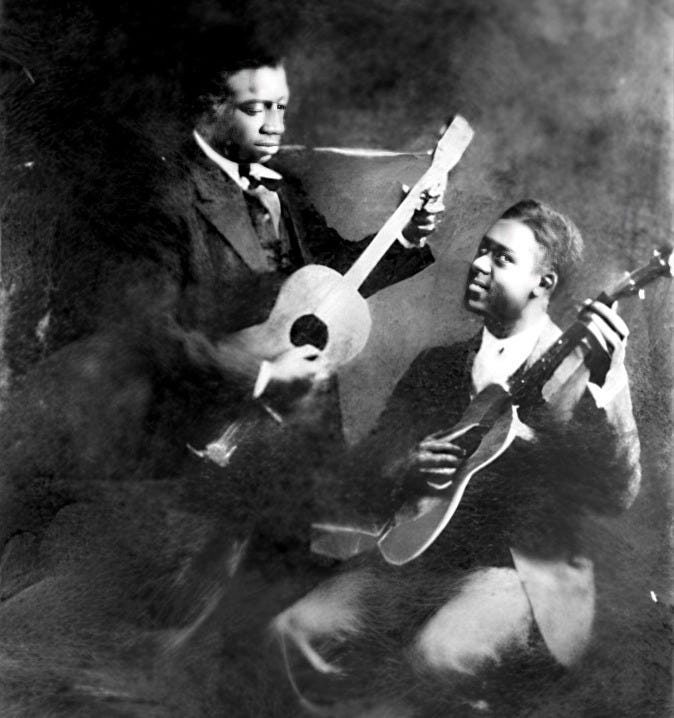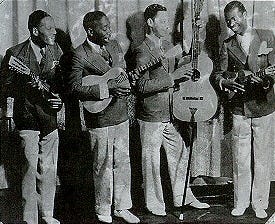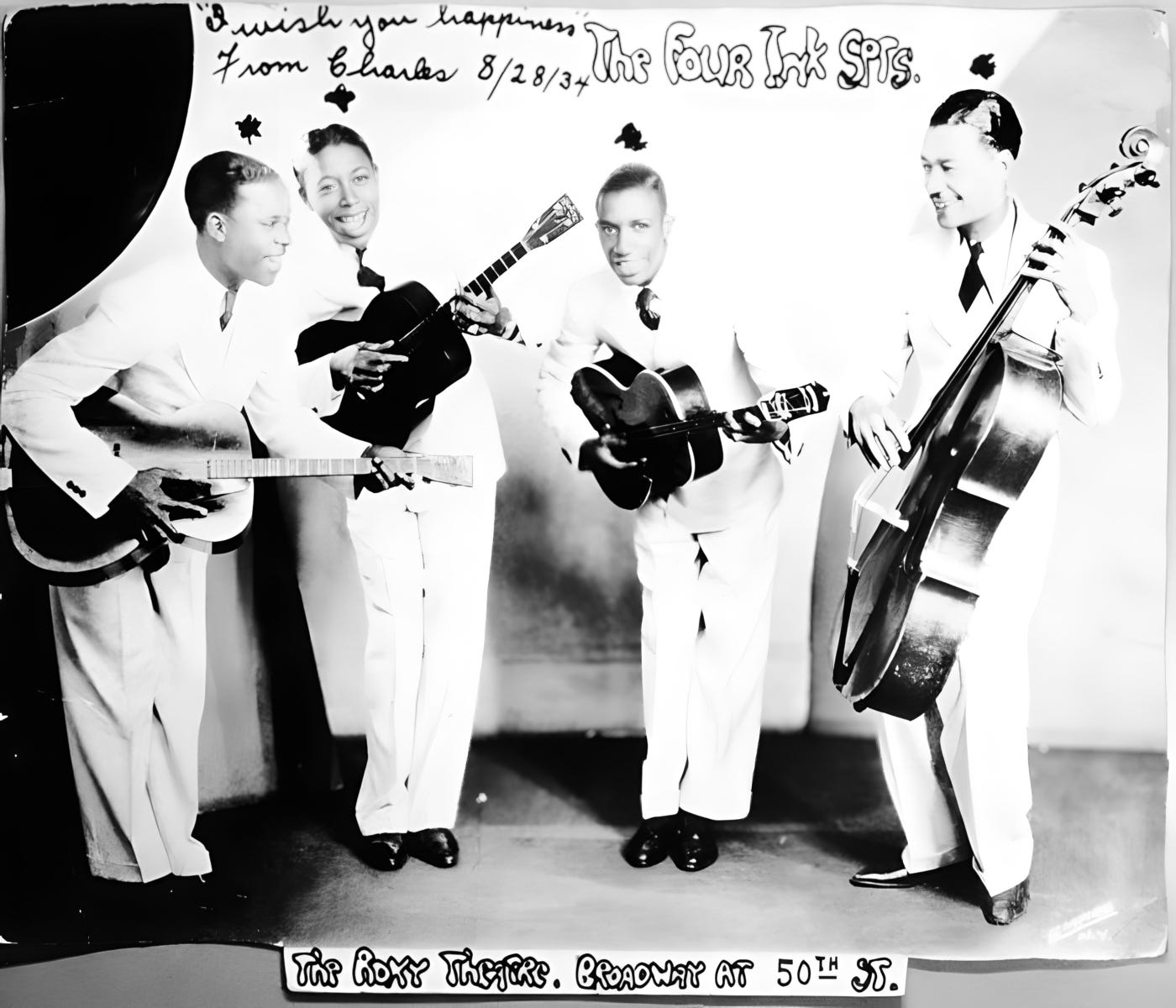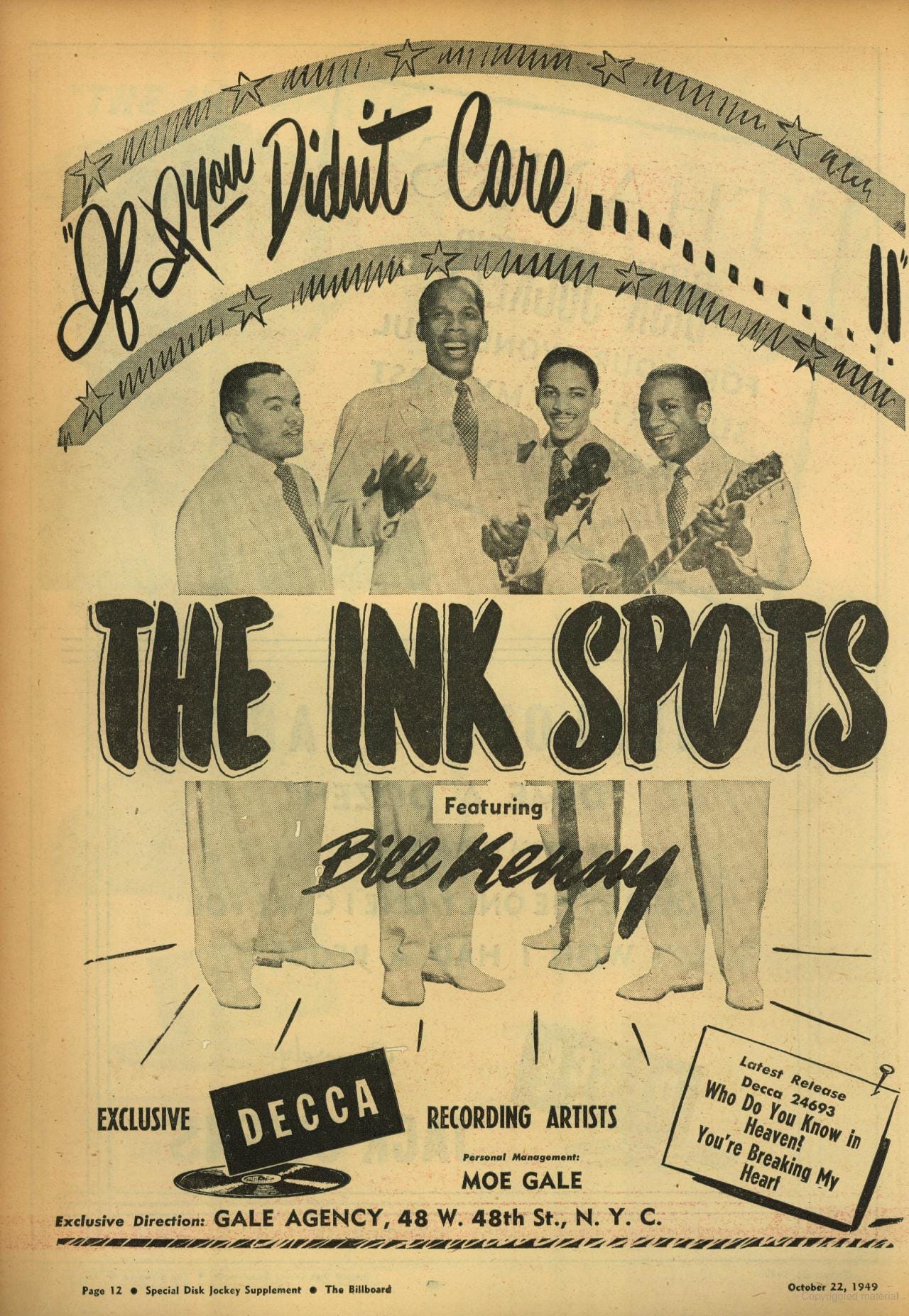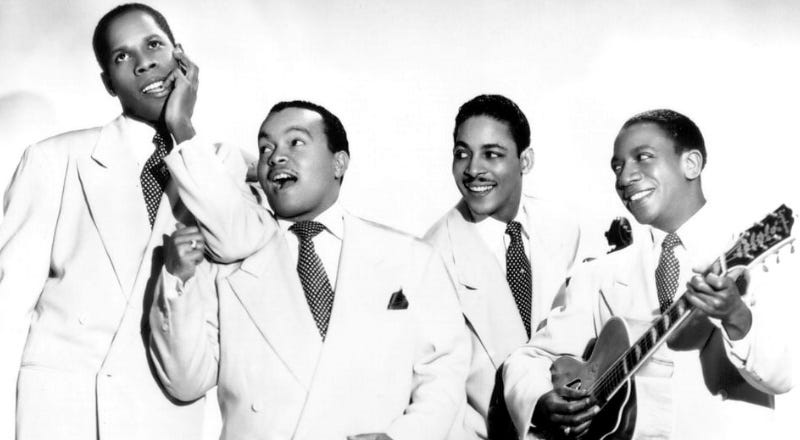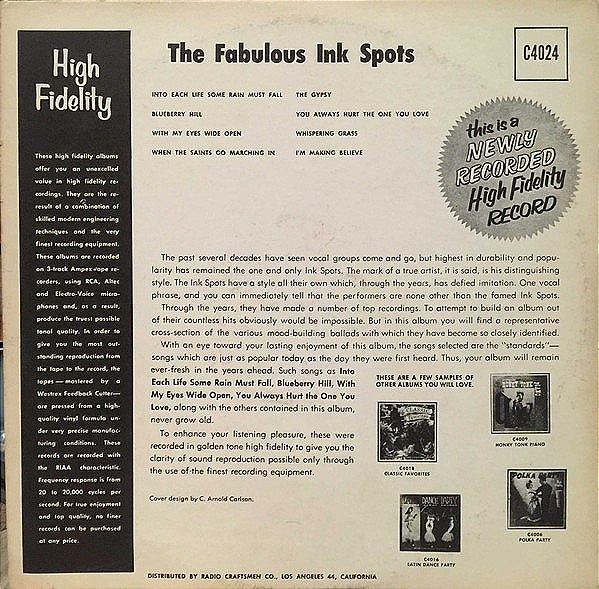Will the Real Ink Spots Please Stand Up?
Since the original vocal jazz group disbanded in 1954, over 100 bands claiming to be The Ink Spots have come and gone over the years.
From 1934 to 1952, The Ink Spots were one of the most popular bands in the whole wide world. By 1949, they had over 30 hits, including 16 singles that reached the #1 spot on the US Pop charts. After many personnel changes and 18 years, the original band ended with only leader Bill Kenny remaining. It, however, wouldn’t be the end of The Ink Spots. Get this! The name was never copyrighted, and what would ensue from 1954 onward would be the coming and going of over 100 bands calling themselves The Ink Spots.
On this week’s episode of I’m Old Fashioned, we listened to songs chosen from records in my record collection. I closed out our journey with two beautiful cuts from The Ink Spots: Their first #1 single from 1939, “Address Unknown,” & “You Were Only Fooling” which went to #8 in 1948.
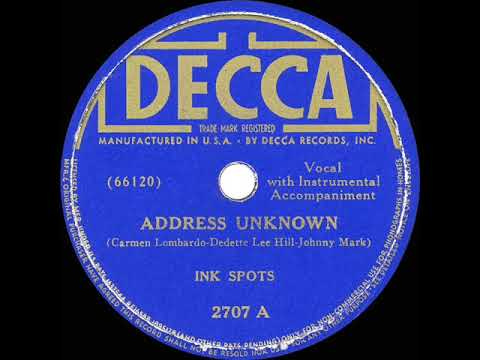

The Beginning with “Jerry & Charlie”
Indianapolis, 1931: Jerry Daniels and Charlie Fuqua start a vocal duo called “Jerry & Charlie”. After playing around town for a while, they landed a spot on the local radio station, WKBF. Over the next year, they would appear 135 times on air. While travelling around for various shows and radio appearances, Jerry and Charlie met Deek Watson and Hoppy Jones, who were part of the band “The Four Riff Brothers”.
When “The Four Riff Brothers” split up in 1933, Deek and Hoppy decided to start a vocal group with Jerry and Charlie called “Kick, Jack, and Lester”. For the next year, they made more regular appearances on various radio shows, and then in 1934, they booked a show at The Apollo Theatre. Around this time, they changed their name to…
“The 4 Ink Spots”
The following year, they recorded their first songs for Victor Records, and although their early recordings as a group weren’t commercially successful, they continued to build a name for themselves. Jerry Daniels left the band that same year despite their growing musical trajectory. At the time, he claimed it was because he was “sick”, but in reality, he left due to the low-paying gig life. Jerry was such an important part of the development of the band’s sound up to that point, but it was his replacement, a 21-year-old singer from Baltimore named Bill Kenny, who would take the Ink Spots into worldwide fame.
The Top & Bottom Technique
After being with the group for two years, Kenny came up with an idea for the band that would not only change the band’s sound dynamically and iconically but also influence the sound of future bands and recordings. Primarily implemented for their ballads, Kenny would sing lead for one verse, then the bass would take the next verse, but recite the lyrics rather than sing them. After the “talking bass” verse, Kenny would come back till the end of the song. The “top & bottom” approach would make its first appearance on a 1938 radio broadcast with the song “Tune In On My Heart”. Soon after that, the classic Ink Spots opening guitar solo would also emerge. Put that all together, and you’ve got the perfect formula for an Ink Spots recording.
19 Million Copies
On January 12th, 1939, The Spots entered Decca Records studios and laid down a recording of “If I Didn’t Care”, a new song by a new promising young songwriter…Jack Lawrence (writer of “All or Nothing at All” & “Beyond the Sea”). This is the record that made The Ink Spots a global sensation. As of 2023, it was still the 8th best-selling single of all time. It was also the first Ink Spots recording to showcase Bill Kenny’s trademark “Top & Bottom” technique.


Each band member was paid $37.50 for the recording session, but after the record sold 200,000 copies, Decca tore up their original contract and gave them an additional $3750. As the new hit sensation entered the 1940s, they would reach the height of their fame. Hit after hit would follow, with their biggest coming in 1946, “The Gypsy” spent 10 straight weeks at #1 on Billboard.
There isn’t a wealth of video available of The Ink Spots performing, but here’s a really special clip that showcases the group’s sound in 1946 and that “Top & Bottom” approach. These outtakes were filmed for a short film on nightclubs in New York called “March of Time” and was filmed at Café Zanzibar on Broadway.
The First Live Television Broadcast In History
In 1936, the first-ever live television broadcast was demonstrated at NBC. The artists showcased in this new era of television were the Ink Spots, making them among the first people ever televised on a live broadcast. This demonstration was only for the press, though, and the general public did not receive the broadcast. It would take over a decade for The Ink Spots to get their second chance, and then history was made “officially”.
The 1940s saw the band often at the top of the charts and even appearing in a few films. Television beckoned next. Over a decade after their appearance on the first-ever live television broadcast, they made history in June of 1948 when they appeared on Ed Sullivan’s “Toast of the Town”. Invited personally by Ed, The Ink Spots would be the first black performers to appear on live national television.
The Ink Spots began to break racial barriers, being invited to play white-only clubs across America. In 1948, they played at Miami’s Monte Carlo Club and were given the top spot over several white bands. No club owners up until that point had previously had an all-Black group as the headliner.
The Height of Popularity & The Changing Tides
The 1940s were the most rewarding times for The Ink Spots, but also full of a number of personnel, and personal changes. In 1943, Charlie Fuqua was drafted to the army and wouldn’t return until 1945; his friend Bernie Mackey would take his place until March of 1945, and then Bill Kenny would ask Huey Long to step in as Charlie wouldn’t be returning until October of that year. 1944 saw long-time bass player Hoppy Jones collapse on stage at Café Zanzibar, he would shortly die after from cerebral hemorrhaging. Cliff Givens replaced Jones on bass briefly until Herb Kenny, Bill’s brother, was chosen as the new permanent bass player; he would stay on with the band from 1945-1951 before making the jump to a solo career. The last bass player of the original group was Adriel McDonald, he was actually the band’s valet. He had sung in the early 40s with Herb Kenny in a band called “The Cabineers”, and Herb chose him as his replacement.
A bit confused? You’re not alone! The chart below lays out the personnel history of the band in more detail for you.
A great site is also below here if you want to dive even further into The Ink Spots lineage: https://www.uncamarvy.com/OriginalInkSpots/Original-Ink-Spots-Family-Tree.htm
Ella & The Ink Spots
It should be noted that between 1943 & 1950 Ella Fitzgerald recorded 7 songs with The Ink Spots, these recordings marked major highlights in both of their careers. 4 of the songs reached the top of the pop charts, with “Into Each Life Some Rain Must Fall” going to #1 in 1944.


The Last of Ink Spots
In 1952, Charlie Fuqua left the band and created his own group also called “The Ink Spots”. He and Bill Kenny each owned 50% of the name at that time, and Kenny took Fuqua to court. The court ruled that Kenny’s Ink Spots were the original band and could continue using that name. The court also ruled that Charlie would have to call his group “Charlie Fuqua’s New Ink Spots”, he, however, disregarded the court’s ruling and named his group “The Original Ink Spots” instead. A few more personnel changes occurred in Bill Kenny’s group, and then he would officially end the one true Ink Spots in July of 1954.
Will the Real Ink Spots Please Stand Up?
After the disbanding of the group in 1954, a number of groups calling themselves “The Ink Spots” started popping up all over America. Many claimed to have the original rights to the name, and lawsuits began flying around between groups suing other groups. Some managed to avoid lawsuits by calling themselves such names as "The Fabulous Ink Spots", "The Famous Ink Spots", "The Amazing Ink Spots", "The Sensational Ink Spots", and "The Dynamic Ink Spots". A judge ruled in 1955 that because the original band was created as a partnership, that partnership ended with the death of Hoppy Jones in 1944, and after that point, no one could really claim to be the original Ink Spots. Over a hundred bands have come and gone since that ruling, a ruling that was made even more final in 1967, when a federal judge ruled that, because so many groups had been using the name “The Ink Spots,” it was now in the public domain, and therefore free for anyone to use.
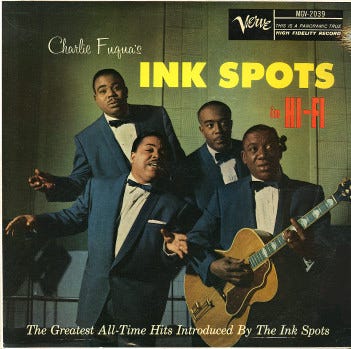
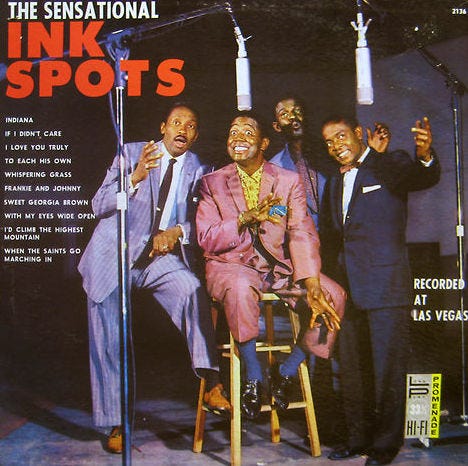

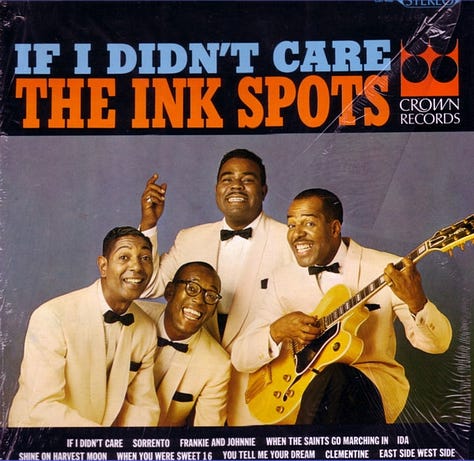
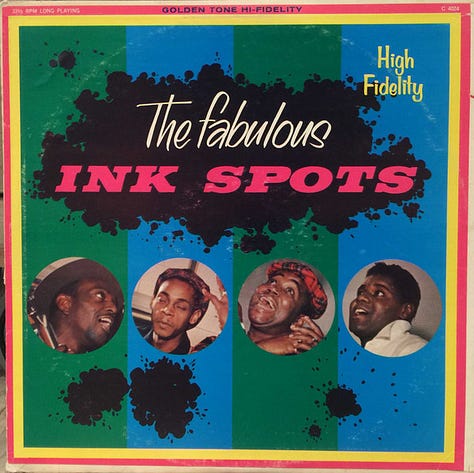
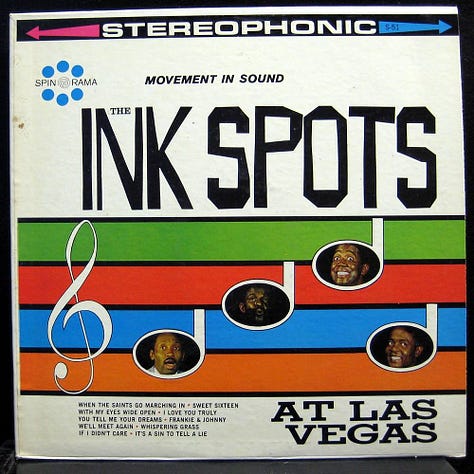
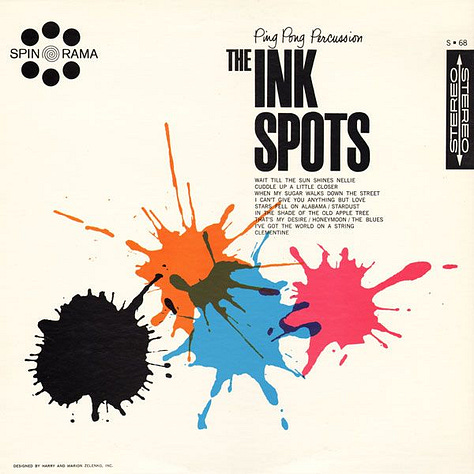
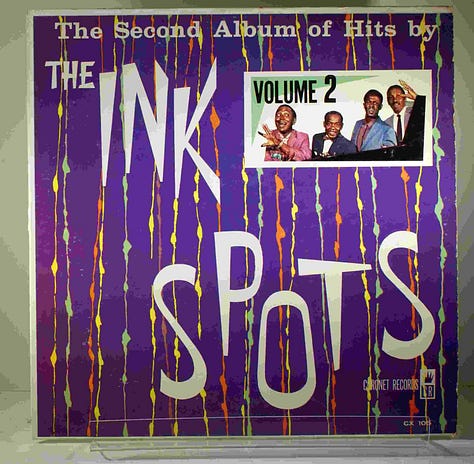
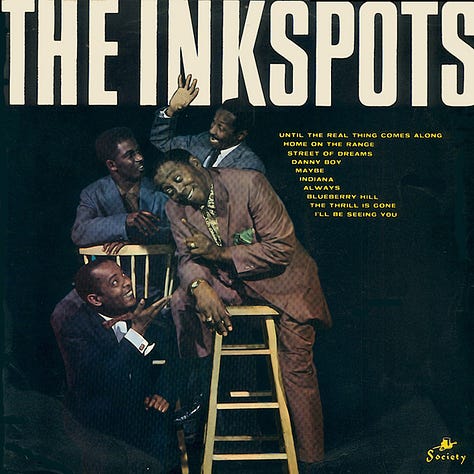
Not the Ink Spots…this back cover from “The Fabulous Ink Spots” even doubles down on them being the original group. I’m guessing that at a time when people didn’t have the internet to go to, these knock-off Ink Spots albums were probably bought by many music fans who fully anticipated or thought they were going to hear the original group.
Setting the Record Straight
In 1989, the Ink Spots were inducted into the Rock & Roll Hall of Fame for their immense contributions to the creation of Doo-Wop, R&B, and early Rock & Roll. Many groups, not just those claiming to be The Ink Spots, were inspired by and continued the style that they created.
It was the original and main configuration that was acknowledged with a special place in music history:
Hoppy Jones, Deek Watson, Jerry Daniels, Charlie Fuqua, and Bill Kenny would be inducted into the Hall of Fame.
*Even though Jerry Daniels left the band and was replaced by Bill Kenny, he still received the honour, as he was so integral to the creation of the group.

Do yourself a favour, and discover (or rediscover) the beautiful musical legacy of The Ink Spots.
Listen to Episode 4: www.mixcloud.com/imoldfashioned
Thank you for supporting I’m Old Fashioned! I am a fully independent artist; I don’t have a manager, agent, label, or team. On Mixcloud and here on Substack, there is an option to donate and support all my creative endeavours. If you like what is being shared, please consider donating anything you can to help cover the cost of making my art during these times.
Sincerely,
Alex




